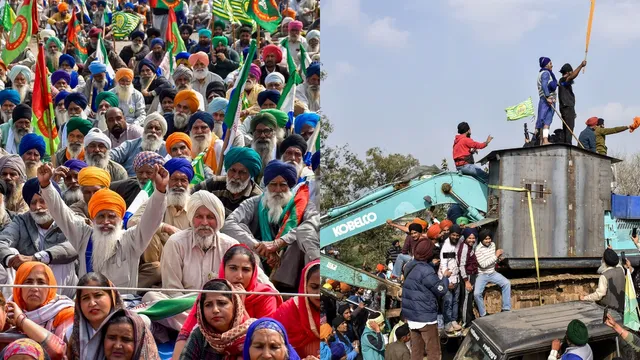Context
The recent resurgence of farmer protests near the Haryana-Punjab state border has once again brought to the forefront the longstanding grievances of agricultural workers in India. Led by groups like the Kisan Mazdoor Morcha and the Samyukta Kisan Morcha, farmers have converged near the national capital, Delhi, demanding significant reforms to address their concerns. Foremost among their demands is a legal guarantee for Minimum Support Price (MSP) for crops and a comprehensive farm loan waiver. Despite several rounds of negotiations between farmer representatives and the Union government, a resolution remains elusive, deepening the impasse between the two sides.
Farmers' Primary Demand and Government's Response:
At the heart of the farmers' agitation lies the demand for a statutory assurance of Minimum Support Price (MSP) for their produce. MSP serves as a crucial safety net for farmers, ensuring a minimum price for their crops and protecting them from market fluctuations. However, the absence of a legal guarantee for MSP has left farmers vulnerable to exploitation by traders and corporations. The government's offer to procure five crops at MSP through contractual agreements for a period of five years failed to appease the protesting farmers. They argue that such arrangements lack transparency and could undermine their long-term interests.
Meanwhile, the Union government maintains that implementing a guaranteed MSP through legislation is not feasible, citing complexities in the agricultural economy. Agriculture Minister Arjun Munda emphasized the need for a comprehensive approach to address the issue, hinting at the challenges posed by various stakeholders in the supply chain. Despite the government's assurances to consider farmers' demands, the lack of concrete action has fueled frustration among agricultural communities, fueling the ongoing protests.
Progression of the March and Clashes:
The farmers' march towards Delhi has been met with formidable obstacles, particularly at the Haryana-Punjab border, where security forces have erected multiple layers of barricades to deter their entry. Reports of clashes between police and protesting farmers have emerged, highlighting the escalating tensions surrounding the movement. Tear gas, water cannons, and other crowd-control measures have been deployed to disperse the agitating farmers, leading to confrontations and arrests. Despite these challenges, farmers remain undeterred, camping near the inter-state boundary and vowing to continue their march towards Delhi.
As the standoff intensifies, the deployment of police and paramilitary forces has been significantly increased along the borders of Delhi to prevent farmers from entering the capital. The government's stringent measures underscore its determination to quell the protests and maintain law and order. However, the steadfast resolve of farmers and their determination to press for their demands signal a protracted standoff that shows no signs of abating anytime soon.
Challenges in Negotiations and Lack of Transparency:
Despite multiple rounds of dialogue between farmer leaders and government officials, a breakthrough has remained elusive, primarily due to divergent positions on key issues. The recent proposal by the government to procure five crops at MSP through contractual agreements failed to garner consensus among farmers, who insist on a legal guarantee for MSP enshrined in law. Moreover, discrepancies in the communication of government offers have further eroded trust between the two parties, with farmers accusing authorities of lack of transparency.
The insistence on clarity regarding the methodology used to determine MSP, whether based on input costs and family labor (A2+FL+ 50%) or comprehensive costs including land rent (C2+50%), reflects the complexity of the issue at hand. Farmers argue that any ambiguity in the proposed MSP framework could leave them vulnerable to exploitation and undermine their livelihoods. Amidst these challenges, the impasse in negotiations persists, deepening the sense of disillusionment among farmers and exacerbating the ongoing crisis.
Conclusion:
The resurgence of farmer protests near the Haryana-Punjab border underscores the deep-rooted grievances and systemic challenges facing agricultural communities in India. The demand for a legal guarantee for Minimum Support Price (MSP) remains a pivotal issue, symbolizing the broader struggle for agrarian rights and economic justice. Despite several rounds of negotiations, the standoff between farmers and the Union government shows no signs of resolution, highlighting the urgent need for constructive dialogue and genuine reforms.
As farmers continue their march towards Delhi, the authorities must recognize the legitimacy of their demands and engage in meaningful dialogue to address their concerns. The use of force and coercive measures only exacerbates tensions and undermines the democratic rights of farmers to peaceful protest. A comprehensive approach that prioritizes the welfare of farmers, ensures fair prices for their produce, and safeguards their livelihoods is essential to achieve lasting peace and prosperity in India's agricultural sector.
|
Probable Questions for UPSC Mains Exam 1. Explain the primary demands of the farmers protesting near the Haryana-Punjab border and their reasons for rejecting the government's offer on Minimum Support Price (MSP). Evaluate the significance of transparency in negotiations between farmer leaders and the Union government. (10 marks, 150 words) 2. Assess the role of government policies in addressing the grievances of protesting farmers, focusing on Minimum Support Price (MSP) and agricultural reforms. Discuss the potential impact of the ongoing standoff on India's agrarian economy and social fabric. (15 marks, 250 words) |
Source – The Hindu








